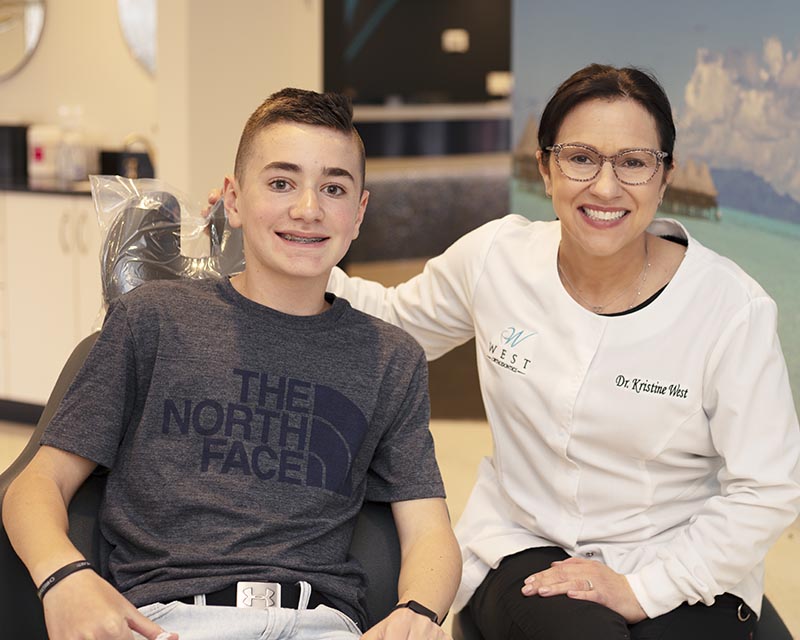Orthodontic Services in East Lansing, Grand Ledge, and DeWitt, Michigan
Exceptional Orthodontic Care for Your Entire Family

Early Treatment
Your trusted kids’ orthodontist, Dr. Kristine S. West, and the entire team at West Family Orthodontics understand that the foundation for a great smile begins during childhood. That’s why we’re proud to offer a variety of kids’ braces that will help set your child on the path toward a lifetime of healthy smiles. We recommend getting a head start on a beautiful smile by having your child visit his or her DeWitt, East Lansing, and Grand Ledge, MI kids’ orthodontist at an early age.
According to the American Association of Orthodontists, a child’s first visit to the orthodontist should be at the age of seven. We agree and encourage parents to have their children visit their DeWitt, East Lansing, and Grand Ledge, MI kids’ orthodontist at this age. The reason for this is because at age seven, the first permanent molars and central incisors have usually erupted and we can more accurately assess the crowding, jaw sizes, jaw relationships and growth pattern by this time. If there is a developing problem, some limited early, interceptive treatment can be initiated to correct this problem and set the child’s growth and development on a more normal path. Early treatment can often take a complex problem and make it easier to treat in the long run, giving the greatest chance for achieving optimal results in the least invasive manner possible.
Having said that, the early screening is to assess for any growth or eruption problems that are developing. If there is a minor concern, Dr. West may recommend watching how the growth and development continues and intercept only if things start to get worse. Sometimes no early treatment is indicated, and you can be confident that if no treatment is needed, Dr. West will not initiate any treatment.
While treatment for most common orthodontic problems will usually start when all of the baby teeth are gone (typically around the ages of nine to 14,) there are some conditions that are actually much easier to treat when they’re taken care of at an earlier age. This is because a child’s natural growth processes have hit their stride during this time. Some of these orthodontic conditions that are great choices for early treatment include the following.
Crossbites – A crossbite is where one or multiple upper teeth bite on the inside of the lower teeth. This is the reverse of how teeth should meet. Sometimes it is a skeletal/growth problem and sometimes it is a tooth eruption problem. At West Family Orthodontics we will assess the cause of the crossbite and prescribe the proper treatment plan.
Crowding – Crowding of the teeth can occur due to a large tooth size, a small jaw size, or a combination of both. There are many different ways to address this issue early and Dr. West will diagnose and create a specific treatment plan based on your child’s unique needs.
Underbites – An underbite is caused when the lower jaw grows forward faster than the upper jaw and the lower front teeth bite in front of the upper front teeth. This is a severe problem that should be addressed as early as possible. If the growth imbalance is left unchecked, jaw surgery could be needed in the future.
Protruding Teeth – Upper front teeth that protrude (or stick out) can be problematic, especially if the child has difficulty with lip closure. Without proper lip closure at rest, protruding teeth are much more prone to being chipped or injured. There are multiple different reasons why this can occur, and at West Family Orthodontics, Dr. West will diagnose and prescribe the proper treatment to resolve this issue.
You may not have realized it, but orthodontic treatment can actually also treat bad oral habits as well. Some of these bad habits can be detrimental to a child’s oral health and hamper the development of his or her teeth, jaws, and mouth.
Thumb or Finger Sucking – This is a natural reflex that many toddlers and babies will have. This habit will typically go away on its own between the ages of two to four, but if the habit persists much longer afterward, the pushing of the thumb against the back of the upper front teeth can cause them to protrude and the suction can change the width and shape of the upper jaw. An anterior open bite can develop as well as a posterior crossbite.
Tongue Thrusting – This is a muscular pattern in which the tongue protrudes between the anterior incisors. This habit will most often occur during speech or swallowing. If left untreated, it can lead to an open bite.
Mouth Breathing – This is an abnormal breathing pattern where a person leaves the mouth open while breathing and air passes straight into the lungs. Mouth breathing can cause both the lower and the upper jaw to grow abnormally.
Choose Your Complimentary New Patient Experience
Adolescent Treatment
Adolescence is a great time to get orthodontic treatment as the last permanent teeth have erupted and the skeletal structure of the face is not fully finished growing. Adolescent treatment is usually between the ages of 13-18, but if the individual is an early developer of permanent teeth, this could be as early as 11 or 12 years of age. While those undergoing treatment at an earlier age (as young as age seven) will have a limited phase of early interceptive treatment, treatment during the adolescent years will be a full comprehensive phase that results in the final positions of the adult teeth and the beautiful smile that you will enjoy for a lifetime!
By the age of 13, most adolescents will have lost all their primary teeth and their permanent teeth have come in. This is an excellent time for us to begin orthodontic treatment and fix any orthodontic problems, such as a bad bite, poor alignment, or tooth spacing problems. It’s also a good idea to perform treatment at this time because orthodontic problems don’t improve with age – they only get harder to treat and more expensive as well.
Some of the reasons why adolescence is the perfect time for orthodontic treatment include the following:
- A teenager’s jaw and face are still developing, making it much easier to treat orthodontic problems than as an adult.
- It will also cost less to treat orthodontic problems at this age than in adulthood.
- The procedure will be quicker because the adolescent has a higher metabolism and therefore usually a faster rate of tooth movement than adults.
This is usually the largest peer group receiving orthodontic treatment at any time and it is great to be finished before high school is completed.
When you first come into our beautiful DeWitt, MI office, you will be warmly greeted and given a tour of the facilities. We will then take a digital scan and a radiograph of your teeth and jaws. After this is done, Dr. West will do a thorough evaluation of your teeth and jaws, then she’ll develop an orthodontic treatment plan that will best suit your needs. Here are some of the most popular treatments that we are likely to use.
Invisalign®
Instead of using brackets and wires to move teeth, Invisalign® utilizes clear aligners to achieve the desired result. Like the name suggests, these aligners are nearly invisible and are made of a clear, plastic material that fit over your teeth. Unlike braces that are attached to the teeth, these aligners can be removed for brushing, eating and special occasions; however, they should be worn for 20-22 hours a day for optimal and efficient results. In the future, braces will mostly be obsolete and thus this is the most technologically advanced method to move teeth. In many cases, Dr. West can achieve the same or better results with Invisalign® over braces and with a shorter treatment time.
Metal Braces
These are the most common form of orthodontic treatment appliances. They achieved their popularity for good reason – they’re an effective, affordable, and time-tested method of moving teeth. Modern metal braces are now even more improved by being smaller and lighter than ever.
Clear Braces
Clear braces are very similar to metal braces, but with one major difference – these braces are made of a tooth-colored ceramic material, granting a patient a much more discreet form of orthodontic treatment. If you’re interested in braces, but you’re worried about how you’ll look in them, clear braces may be a great option for you.
Unfortunately, there’s really no general answer to this question – it entirely depends on the individual. Typically, the active stage of orthodontic treatment can last anywhere from six to 30 months, although the average time in treatment is 14-18 months. Each patient will get a personalized treatment plan from Dr. Kristine West, which will provide you with an estimate for how long treatment will last. After that, you’ll need to wear a retainer for another period of time in order to help maintain your new and improved smile.


Adult Treatment
At West Family Orthodontics, we aim to provide high-quality orthodontic treatments, such as Invisalign® and braces, to patients of all ages from the DeWitt, East Lansing, and Grand Ledge, MI areas. While many patients believe that they’re too old for braces, Dr. Kristine West frequently works with adult patients.
In fact, Dr. West has become the leading orthodontic provider of adults in the area! You’re never too old to take advantage of the benefits that orthodontics has to offer; in fact, 25 percent of all orthodontic patients are adults. If you’ve ever been interested in braces for adults, now’s a better time than ever!
While teeth can be straightened at any age, there are two differences with adult treatment. The first is that adults have already completed their growth and development of their jaws. This means that completely changing the actual jaw structure cannot be accomplished with orthodontic appliances alone, the way that it can be with a growing child or adolescent.
The second difference is that in adults, there is a higher risk of periodontal (gum and bone) disease and this needs to be assessed prior to starting orthodontic treatment. If the gums and bones supporting the teeth are not healthy, orthodontic treatment cannot be started because this could lead to tooth loss. Dr. West will want all adults to have a thorough periodontal evaluation by their dentists prior to starting orthodontic treatment. At the initial consultation, this will be discussed with the patient on an individual basis.
While all orthodontic appliances work by employing light, continuous force in order to move teeth into proper alignment, how these forces are applied can vary. As numerous orthodontic innovations have become available in recent years, it’s given us many different options for giving you an even more beautiful smile.
Clear Aligners (Invisalign®) – Instead of using brackets and wires to move teeth, Invisalign® utilizes clear aligners to achieve the desired result. Like the name suggests, these aligners are nearly invisible and are made of a clear, plastic material that fit over your teeth. Unlike braces that are attached to the teeth, these aligners can be removed for brushing, eating and special occasions; however, they should be worn for 20-22 hours a day for optimal and efficient results. In the future, braces will mostly be obsolete and thus this is the most technologically advanced method to move teeth. In many cases, Dr. West can achieve the same or better results with Invisalign® over braces and with a shorter treatment time.
Traditional Metal Braces – These are the most common form of orthodontic treatment appliances. They achieved their popularity for good reason – they’re an effective, affordable, and time-tested method of moving teeth. Modern metal braces are now even more improved by being smaller and lighter than ever.
Clear Braces – Clear braces are very similar to metal braces, but with one major difference – these braces are made of a tooth-colored ceramic material, granting a patient a much more discreet form of orthodontic treatment. If you’re interested in braces, but you’re worried about how you’ll look in them, clear braces may be a great option for you.
After your orthodontic treatment is complete, you’ll need to wear a retainer. While the orthodontic treatment was meant to move your teeth into place, the retainer is designed to keep your teeth in their new positions. When teeth aren’t held in place by a retainer long enough for the supporting bone to develop around them, they can potentially drift back into their original, misaligned positions. Make sure to wear your retainers as instructed so that all your hard work and effort during the treatment doesn’t go to waste.
Meet Some of Our Amazing Patients and Their Families








